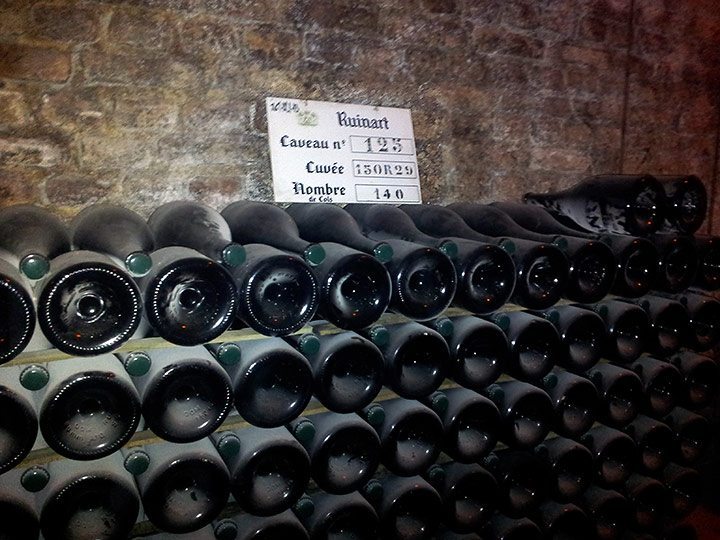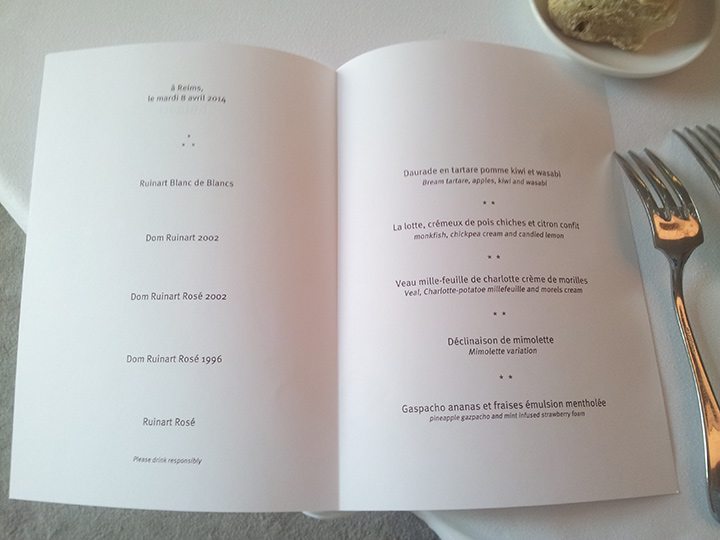A wonderful way to start the week
Recently Moet Hennessy arranged a seamlessly well organised and enjoyable trip to Reims (North East of Paris) to visit two of the large Champagne Houses – of which I will be concentrating on the second – Dom Ruinart.
On Tuesday morning, after a large breakfast of bacon, sausages and scrambled eggs in our hotel (and a quick swim for others), we took a short bus journey to Ruinart HQ on the outskirts of Reims – a beautiful old monastery recently restored to its former glory.

The newly renovated Ruinart wing and gardens
We were met by the extremely energetic and passionate Emily who wasted no time in leading us down to the cellars ‘Les Crayères’ – originally used by the Romans as chalk mines and later adopted by Champagne producers as storage and production facilities due to their stable ambient temperatures.
During World War I André Ruinart had to move his business underground after the original building was destroyed by heavy shelling. Subsequently the Crayéres flooded making running the business in the chalk cellars virtually impossible. Undeterred, André built a raft and conducted his business whilst bobbing around the water logged passages.
Ruinart is thought to be the first wine house in Champagne totally devoted to the production of sparkling wine. In 1729 Nicolas Ruinart, who was fascinated by the tales of Dom Pérignon, started producing the fizzy wine and one year later launched his Champagne onto the European Market.
As the champagne business grew, so too did the need for more storage. Claude Ruinart became the first wine producer to buy eight kilometers of the Roman chalk crayères dug out under the city of Reims in 1768.
Ruinart now has over 18 kms of cellars, all built into the chalk (sometimes up to 38 m below the ground) with three different levels interlinked by lifts.

A model of the Crayère chalk pits
After negotiating the steps leading down to the dimly lit warren of passageways that make up the cellar (they are purposely kept dark and any lights are filtered so as to avoid affecting the wines) Emily took us to the disgorging area, where we viewed the process from behind a glass wall.
Ruinart perform disgorgement mechanically using inert nitrogen gas to avoid any chance of oxidation. The recognisable freshness of all Ruinart champagnes – a signature element of Ruinart’s house style – relies on a reductive maturation which was particularly noticeable when we tried the champagne later on.
Ruinart is often called “The Chardonnay House” and their aim is to produce an “elegant, full and generous taste,” according to Michael Edwards, author of “The Finest Wines of Champagne.” To balance the more austere flavours of the Côtes de Blancs, the producers source grapes from other areas including Montage de Reims, the Sézannais and the Côte du Pertois (Typically, only 10% of Ruinart’s total production come from their own vineyards).
Cellar Master Frederic Panaïotis focuses enormously on the reductive method. Stainless steel tanks are used to make all Ruinart’s wine. To reduce oxidation, Frederic uses nitrogen, an inert gas to protect the wine. Bottle aging then takes place in the crayères for long periods of time producing the subtle autolytic flavours found in Ruinart Champagne.

The automated disgorgement process
Following the disgorging process we were led yet further down, all the time the conditions were getting slightly cooler and more humid, up to 80% on the second level and 90% on the third in fact.

Funghi growing in the damp humid conditions
We viewed row after row of vintage champagne in different stages of its life. Bottles stacked neatly on top of each other disappeared down endless corridors. The whole operation is a real logistical challenge!

Ruinart Magnums on the lees – the vintage encrypted in the Cuvée number
Emily, now showing off a bit, took us into a larger room to show us the crates used to transport champagne to famous figures such as the Duke of Edinburgh, Roosevelt and the Duke of Marlborough, their names neatly stamped onto the wood.

One of a number of famous customers!
The further we walked, the more one was aware of the history surrounding us. From the large roman crayeres (pits used to mine chalk for building materials) to the graffiti etched into the walls by second world war service men using the cellars as bomb shelters.

The deepest Crayère with blanc de blancs on its lees.
This briskly came to an end, when, from out of nowhere, we arrived at a lift which shot us back up to ground level where we emerged into the bright daylight as though emerging from a secret underground lair.
As if being rewarded for our earlier hard work, we were met in the smart new bar (reminiscent of 1970’s style bar from the set of Austin Powers) by waiters clutching trays of perfectly chilled Ruinart brut champagne and delicious extra fluffy cheese puffs, touted as the ‘best cheese puffs in France’ by the Chef de Cave Ruinart, Frédéric Panaïotis.

‘Yeah, baby, yeah!’
What followed was a four course tasting lunch hosted by Frédéric with the menu designed and cooked by local chef Valerie Radou. Each dish beautifully paired with a different champagne produced by Ruinart. In particular the starter of bream tartare with apples and kiwi which worked perfectly with the freshness of the Chardonnay driven Ruinart Blanc de Blancs NV, the hint of wasabi highlighting the delicate effervescence on the palette, but balanced by the creaminess

After lunch, it was, with the most reluctance, that we said our farewells and set off back to Paris to catch the 17.58 Euro Star service back to London and real life.